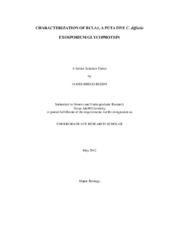Characterization of BclA1, a putative C. difficile Exosporium Glycoprotein.
Abstract
Clostridium difficile is a spore forming, anaerobic bacterium that can cause diarrhea, pseudomembranous colitis, and toxic mega colon in susceptible hosts. C. difficile spores are highly resistant to extreme chemical and physical environments, and are likely the infectious agent. Spores are formed and matured inside of a mother cell and released into the environment when the mother cell lyses. During spore formation, a loosely attached outer layer, the exosporium, is added before mother cell lysis. The function of the C. difficile exosporium is not known, but has been studied in several Bacillus spp. In Bacillus cereus, the exosporium is the primary barrier that interacts with the host environment, helps the spore adhere to surfaces, and escape phagocytosis by macrophages. In C. difficile 630, bclA1 is an orthologue of B. anthracis bclA and B. cereus bclA, and is a possible exosporium glycoprotein. Mutant C. difficile strains lacking these proteins may have effects on spore adhesion, germination, and spore architecture. Here we attempt to mutate C. difficile bclA1 through TargeTron technology. Though no mutations were observed, we did isolate erythromycin-resistance colonies, suggesting a mutation had been generated, possibly at another locus. Erythromycin-resistance is likely induced by a RAM erythromycin-resistance gene activated upon a TargeTron insertional event. Further studies will be done to determine the location of the TargeTron mutation. In addition, to determine the location of BclA1, spores with a fluorescent tag were generated and will be viewed under fluorescent microscopy.
Citation
Reedy, James 1990- (2012). Characterization of BclA1, a putative C. difficile Exosporium Glycoprotein.. Honors and Undergraduate Research. Available electronically from https : / /hdl .handle .net /1969 .1 /154431.


